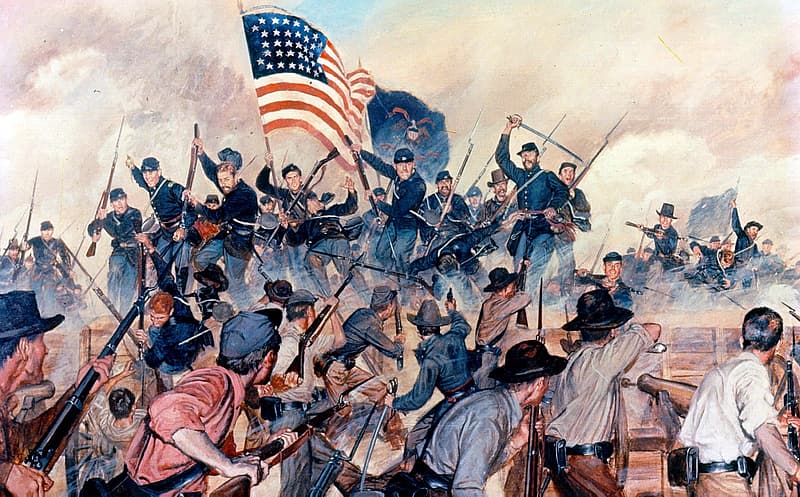The Complex Causes of the American Civil War: Unravelling the Tangled Roots of a Nation Divided
Discover the tangled web of factors that led to the American Civil War. From slavery to sectionalism, delve into the complex causes of a nation divided

The American Civil War was a pivotal moment in American history that changed the course of the country forever. Around 600,000 People died during the conflict, which lasted from 1861 to 1865, and it also put an end to slavery in the country. The origins of the Civil War were complicated and multidimensional, involving sectionalism, states' rights, slavery, and economic disparities. Each of these elements will be thoroughly discussed and their contributions to the start of the war will be examined in this blog article.
A list of figures highlighting the differences in recourses of the North and South
- Total population:
Union: 22,300,000; white males = 4,600,000
Confederacy: 9,100,000; white males = 1, 100,000
Union Advantage: 2.5 to 1; white males = 4.2 to 1
- Value manufactured goods:
Union: $1,730,000,000
Confederacy: $156,000,000
Union Advantage: 11 to 1
- Railroad mileage
Union: 22,000
Confederacy: 9,000
Union Advantage: 2.4 to 1
- Coal production (in tons)
Union: 13,680,000
Confederacy: 650,000
Union Advantage: 21 to 1
- Corn/wheat production (bushels)
Union: 698,000,000
Confederacy: 314,000,000
Union Advantage: 2.2 to 1
- Draft animals
Union: 5,800,000
Confederacy: 2,900,000
Union Advantage: 2 to 1
- Cotton production (bales)
Union: 43,000
Confederacy: 5,344,000
Confederacy Advantage: 1 to 124
Slavery
A significant factor that led to the start of the Civil War was slavery. Many Southerners believed that their way of life depended on the ongoing use of slave labour since slavery was so engrained in the region's economy. 3,953,760 slaves were counted in the 1860 U.S. Census, the majority of which were centred in the Southern states. Over 40% of the population in South Carolina and over 30% in Mississippi, Alabama, Georgia, and Louisiana were slaves in 1860.
Slaves were the single largest asset in the Southern economy at the time, demonstrating the immense economic importance of slavery. According to historian James McPherson,
"In 1860, slaves as property were worth more than all the banks, factories, and railroads in the United States combined."
According to estimates, the value of slaves in the South was over $3 billion, or roughly 16% of the total national wealth.
Leading slaveowners had a big impact on Southern politics and culture. For instance, the future president of the Confederacy, Jefferson Davis, kept over 100 slaves on his Mississippi estate. Many slaves were held by Robert E. Lee, the Confederate general who is recognised as one of the greatest military leaders in American history.
Slavery abolition efforts encountered opposition throughout the South. The Kansas-Nebraska Act of 1854 repealed the Missouri Compromise of 1820, which aimed to achieve a balance between the number of free and slave states in the Union. The Compromise of 1850, an effort to settle disagreements on slavery in new territories, was mainly ineffective. The final straw for many Southerners was Abraham Lincoln's election in 1860, who opposed the expansion of slavery. As a result, numerous Southern states seceded from the Union.
States' Rights
Another important aspect in the start of the Civil War was the issue of states' rights. Many people in the South felt that the federal government was interfering with the rights of their states, particularly when it came to slavery. Southern states contended that if they thought their rights were being violated, they had the right to separate from the Union. The Nullification Crisis of 1832, when South Carolina threatened to nullify federal tariffs, was largely driven by this conflict over states' rights. A solution was ultimately reached to end the situation, but it created a precedent for Southern states to defend their statehood.
Leading proponents of states' rights were very influential in Southern politics. South Carolina senator, John C. Calhoun, was a major supporter of nullification and states' rights. Calhoun contended that states had the right to overturn federal laws they deemed unconstitutional in his 1831 "Fort Hill Speech." Another well-known supporter of state's rights was Alexander Stephens, who later rose to become the Confederacy's vice president. Stephens said in his infamous "Cornerstone Address" of 1861, that the Confederacy's cornerstone was
"the great truth that the negro is not equal to the white man; that slavery, subordination to the superior race, is his natural and normal condition."
Economic Differences
Economic disparities between the North and South aided in the start of the Civil War. While the South was predominantly an agricultural economy that depended on cash commodities like cotton, the North was an industrial economy. Tensions over trade and tariff policy resulted from this economic gap. While the South opposed tariffs because they would increase the cost of imported commodities and hurt their agricultural economy, the North supported protective tariffs that would benefit local businesses.
The political parties in the North and South each reflected the economic divisions between them. The Republican Party, which was founded in the 1850s, was predominately based in the North and supported policies like protective tariffs that would help Northern industry. The Democratic Party, which predominated in the South, supported free trade and states' rights.

Political Divisions
Political disagreements over slavery and state rights also played a part in the commencement of the Civil War. Abraham Lincoln was elected as president in 1860 as a result of the Democratic Party's inability to unite its divided Northern and Southern factions around a candidate. Many Southerners considered Republican Abraham Lincoln, who opposed the spread of slavery, to be a threat because they thought he would try to outright abolish it.
Several Southern states left the Union after Lincoln's victory, breaking apart the Union. First to secede was South Carolina in December 1860, then came Mississippi, Florida, Alabama, Georgia, Louisiana, and Texas. With Jefferson Davis serving as their president, these states united to form the Confederate States of America.
Sectionalism
Another reason in the start of the Civil War was sectionalism, or the idea that one's own region is superior to others. There was a sense of regional identity and allegiance because the North and the South had different cultures and economies. The media helped to strengthen this sense of regional identity by highlighting the distinct interests and points of view of Northern and Southern publications.
Since slavery was a defining aspect of Southern society and culture, it was at the heart of this sectionalism. Many Southerners saw themselves as protectors of their lifestyle and thought Northern abolitionists were attempting to upend their social structure and economy. Similar to this, many Northerners considered slavery to be a moral sin and thought that by holding to it, the South was thwarting democracy and development.
Finally, it should be noted that the American Civil War had numerous, intricate reasons. A number of factors contributed significantly to the start of the war, including sectionalism, states' rights, economic disparities, and political disagreements. The American Civil War was a turning point in history that affected the country for decades. In the end, it led to the abolition of slavery and the restoration of the Union, but it also left the nation with serious wounds that took a long time to heal. To grasp the history and identity of the United States, one must comprehend the reasons behind the Civil War.




